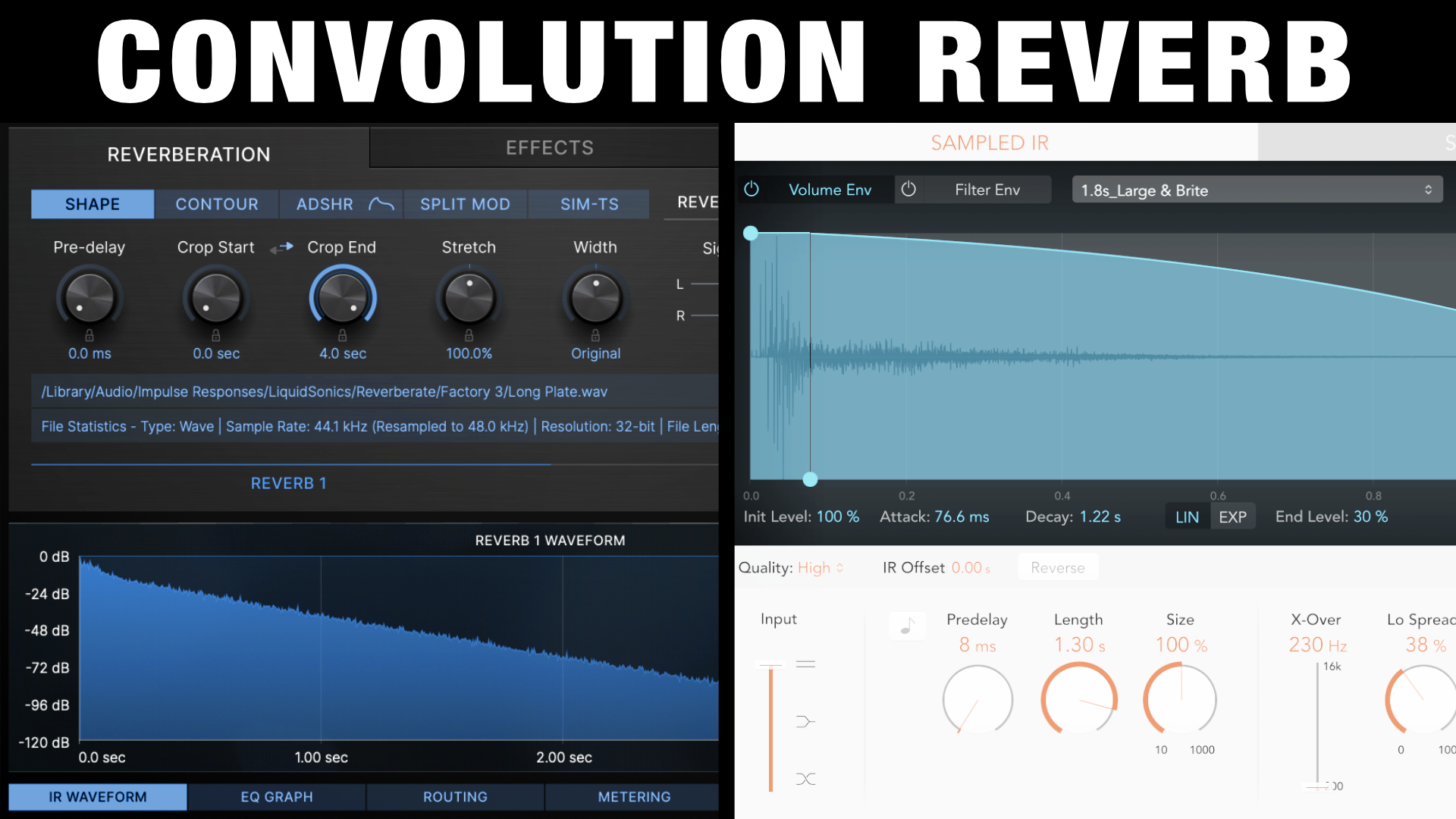 Convolution reverb is a type of digital reverb that uses impulse responses (IRs) to capture the characteristics of a real-world acoustic space or other sound source. It works by convolving the IR with the input signal to create the reverb effect.
Convolution reverb is a type of digital reverb that uses impulse responses (IRs) to capture the characteristics of a real-world acoustic space or other sound source. It works by convolving the IR with the input signal to create the reverb effect.
What is an Impulse Response (IR) file used in Convolution Reverbs?
An impulse response (IR) is a recording of the impulse response of a particular acoustic space or other sound source. An impulse is a very short, sharp sound that is used as a “stimulus” to measure the response of a system.
In the context of convolution reverb, an impulse is used to excite the acoustic space or sound source, and the resulting response is captured and used as an IR.
To use a convolution reverb, you first need to obtain an IR of the space or sound source you want to simulate. This can be done by recording an impulse in the space and capturing the resulting response, or by using a pre-recorded IR.
Once you have an IR, you can use a convolution reverb plug-in or software to convolve the IR with the input signal.
Convolution reverb is known for its high level of realism and is often used to recreate the sound of specific spaces or to create unique sounds.
It is commonly used in music production, film and television sound design, and live sound reinforcement to add a sense of realism and atmosphere to a sound.
One of the benefits of convolution reverb is that it can capture the subtle characteristics and nuances of a specific acoustic space or sound source that may not be possible with other types of reverb.
It can also be more efficient in terms of CPU usage compared to other types of digital reverb, as the IR can be pre-computed and stored, allowing the convolution process to be performed in real-time.
Convolution Reverb – Main Benefits
- High level of realism: Convolution reverb is known for its high level of realism, as it uses impulse responses (IRs) to capture the characteristics of a specific acoustic space or other sound source. This can be particularly useful for recreating the sound of specific spaces or creating unique sounds that may not be possible with other types of reverb.
- Efficiency: Convolution reverb is generally more efficient in terms of CPU usage compared to other types of digital reverb, as the IR can be pre-computed and stored, allowing the convolution process to be performed in real-time. This can be particularly useful for situations where CPU resources are limited, such as when using a laptop or working with a large number of tracks.
- Versatility: Convolution reverb allows you to use a wide variety of impulse responses, giving you a lot of flexibility and versatility in terms of the spaces and sounds you can simulate. You can use IRs of real-world spaces, or use IRs of other sound sources, such as vintage hardware reverb units, to create unique sounds.
- Consistency: Convolution reverb can be useful for maintaining consistency across different sessions or projects, as you can use the same IRs across different tracks or mixdowns. This can be particularly useful for situations where you need to recreate a specific sound or maintain a consistent sound across different projects.
- Ease of use: Convolution reverb plug-ins and software are generally easy to use, with a user-friendly interface and a wide range of controls and settings. This can make it easy to find the sound you are looking for and make adjustments as needed.
Convolution Reverb – Main Disadvantages
- R size: Convolution reverb requires impulse responses (IRs) to function, and these IRs can be quite large in terms of file size. This can be an issue if you are working with a limited storage capacity or if you need to transfer IRs between computers.
- IR quality: The quality of the IR can have a significant impact on the quality of the resulting reverb. If you are using low-quality IRs, the reverb may not sound as good as it could. It is important to use high-quality IRs to get the best results with convolution reverb.
- Lack of flexibility: Convolution reverb is generally less flexible than other types of digital reverb, as it is based on the characteristics of a specific space or sound source. This can make it more difficult to make drastic changes to the sound or to create more abstract or otherworldly sounds.
- CPU usage: While convolution reverb is generally more efficient in terms of CPU usage compared to other types of digital reverb, it can still be resource-intensive, particularly if you are using multiple instances of the plug-in or working with a large number of tracks. This can be an issue if you are working with a computer with limited CPU resources.
- Compatibility issues: Some convolution reverb plug-ins and software may not be compatible with certain DAWs (digital audio workstations) or operating systems, which can be a limitation if you are using a specific platform.
